Nirit Weiss-Blatt's Blog, page 3
March 21, 2022
#TechlashBook on Podcasts – Emerald Podcast Series
Thank you, Iram Satti, for having me on your podcast.
The transcript below, via OtterAI, was slightly edited for clarity.
Emerald Podcast Series - Understanding the Techlash Era - Apple Podcasts / Google Podcasts / Spotify

Iram: We’re going to talk about your book, called “The Techlash and Tech Crisis Communication,” which is due to be published as a paperback this March 2022.
What led you to research the tech field and (then to) write a book about it?
Nirit: I’ve been working in the tech field since 2005, 17 years ago, so before my academic journey, I was in the tech industry. I worked in both tech journalism and tech public relations. So for years, I made a lot of tech-savvy pieces, enjoyed covering the cutting-edge innovation coming from Israel.
When I was a deputy editor, and finished my Master’s degree in Communication and Political Science, I looked for academic examinations of my field - the tech coverage – and found none. A significant gap in the literature -a lack of both theoretical and empirical work on the interplay between my worlds - tech journalism and tech PR. So, with my background in both, I decided to investigate it myself.
For five years of my Ph.D. in communication, I analyzed the tech media agenda. One of the judges of this dissertation actually wrote “who cares about tech news?” He was so into political communication, and only political news, that I needed to explain why tech journalism is actually important. Today, I don’t need to do it anymore, right? But the beginning was tough, I must say.
In the additional five years after that, as a research fellow at USC Annenberg, I focused on the emerging Techlash, the tech-backlash. The thing is that when I started this research project in 2016, the tech media was not tough - at all. So, my criticism, back then, was about the cheerleading writing style, the non-investigative nature of the coverage and the immense influence of corporate PR.
But in the course of my study, we moved from Big Tech being “our saviors” to “our threats”, or from “it’s so cool” (everything) to “it’s so evil.” So, a lot has changed.
The research that I’ve done explains this massive shift, reveals the underlying causes of the backlash, and the strategies the companies used to defend themselves from all the growing scrutiny. I had so much data about it, that it turned into a whole book that I, gladly, published with you.
Iram: The book's storyline is organized chronologically. You’ve broken it down to Pre-Techlash, Techlash, Post-Techlash. That’s a clear, consistent way for any reader to understand the work. Can you walk us through why, and what you have learned about those eras? What are the defining milestones that mark the end and then the beginning of a new era?
Nirit: Sure, Yeah. I organized the story in this chronological order because the historical background is crucial here, to understand the magnitude of the change.
But each phase had several changes within, and it’s not that dichotomic. But one of the book's points is that we are currently on the dystopian side because we spent a great deal of time on the utopian side.
So, the “Pre-Techlash Era” section depicts that for decades, the tech companies were used to -mainly flattering coverage. We had plenty of computer magazines that pushed a “fanboy” culture. And all the tech CEOs wished to be on their covers. Kara Swisher, who was interviewed for the book, called it the “celebrification” of the tech founders; they were like celebrities, like rock stars.
One of the things that were crucial in the past, is how tech companies took advantage of the hunger for information, and people wanted to be close to those rock stars. In this power dynamic, many conversations were “on background,” meaning the journalist cannot use and share any of the info gathered. So, there was always this tight control with secrecy and limited access. This power imbalance (it’s one of the points in my book) heavily contributes to the tension between the media and Big Tech.
The roots are in the past. And this is why the “Pre-Techlash era” section set the stage and help explain the current tech journalists’ revolt (we can say). I mean, they had enough (they just had enough).
But, of course, real-life events shifted the tech coverage, and they all appear in the main section of the book, it’s the Techlash era, which starts at the end of 2016, but focuses on 2017 (and I an explain why).
The last chapter, the “Post-Techlash” is about the growing criticism of Big Tech, moving forward. So, predictions.
Iram: Your study reveals the roots of the change in tech journalism. What are the main contributing factors that caused this shift?
Nirit: We, in academia, were yelling at the tech journalists that they have to be tougher on everybody, specifically Big Tech. In 2017 (as I said) tech journalists indeed began to get tougher.
So, what I’ve done is I used an AI-powered media monitoring tool (by Harvard) and I retrieved more than a quarter-million articles from the tech coverage.
In a typical Pre-Techlash year, the big tech companies’ peaks of coverage, in their yearly timeline, were just like the product launches and business reporting. Those were the main stories. We had negative stories all the time - failures, investigations, fines, privacy issues - we had them all. But they drew considerably less coverage compared to (what I called) “Product Journalism.”
What I saw when I analyzed 2017 was that the big stories in the coverage were totally different and very negative, with a lot of tech scandals. So, that was a big shift that the data showed me.
In addition to the media monitoring and content analyses, I conducted interviews with actors in the tech industry: tech PR executives from global PR agencies and leading tech journalists. They came from leading places - Reuters, TechCrunch, The New York Times, WIRED magazine, and so on. Together, with all their testimonies, they actually illuminated the “inside story” of the Techlash.
They were really open and honest and they said “on the record” that what formed the tech backlash was the election of Donald Trump. They were blaming social media for the U.K.’s Brexit referendum before that. But their pivotal moment was the post-presidential election and the role of social media in helping Donald Trump.
Then, new revelations regarding the Russian interference with the U.S. election evolved into a bigger story. And micro-targeting advertising became this force of evil.
The other thing that came from the interviews is that, you know, it’s the tech companies’ scale and bigness, being too big to fail. Generally, if people feel that companies have gotten too powerful, too big, too rich, that in itself creates a backlash, right? The realization of the power of Big Tech just sank in, and people started to question it a lot more.
I mean, they all started as startups, now they are the establishment, the biggest companies in the world. So, if you look at the Techlash today, it is mostly focused on them, right? Those few dominant companies that we can mention.
On top of that, the data also showed me that focusing only on the political campaigns, such as Brexit or Donald Trump, or the companies’ bigness - won’t do justice to the Techlash.
We had various cases of extremist content and hate speech; major cyberattacks or data breaches, which raised the alarm about privacy violations and data protection; we had a wave of allegations of an anti-diversity, sexual harassment, and discrimination culture in Silicon Valley and beyond. So, I basically documented the accumulation of various issues at once that ‘broke the camel’s back.’
Iram: Your study also analyzed the Tech PR responses and introduced the concept of "Tech Crisis Communication." What can we learn from the tech companies' strategies?
Nirit: Sure. The Techlash caused a reputational decline of an entire industry, right? So, I decided to ask: How do the companies defend themselves from this growing scrutiny? So, I conducted a comprehensive content analysis of the tech companies’ press releases and spokespersons’ statements to journalists.
Despite having different companies and different stories (as I mentioned), the responses were very much alike. The companies rolled out the same playbook, over and over again. So, I created an explanation of this playbook (in the book), it’s called the “Tech PR Template for Crises.” It was pretty clear that Big Tech was not ready to give real answers to tough questions.
So, I broke it into three main stages.
One strategy was The Victim-Villain framing. It goes along this line: “We've built something good, with good intentions, and we have previous good deeds and we have strict policies, but our platform was manipulated/misused by bad/malicious actors” - blaming those outsiders.
The second was Pseudo-apologies, if you remember all the “apology tours” of Mark Zuckerberg after Cambridge Analytica (and everything). Many of the responses included messages of “we apologize,” “deeply regret,” and “ask for forgiveness.”
Those messages were usually intertwined with “we need to do better.” Do you know this sentence? Tech companies use it a lot. It usually comes in this order: “While we’ve made steady progress, we have much more work to do,” and “we know we need to do better.” It’s like the ending of every press release, “we know we need to do better.” Every tech reporter has heard this specific combination a million times by now.
I’ve mentioned that they said sorry, sorry and sorry – so, why pseudo-apologies? Well, because when you look at the literature, they used all the possibilities of reducing their responsibility. All the elements that I mentioned in the previous stage- the reminder strategy = mentioning the past good work; the excuse strategy = “we have good intentions”; the victimization = “We are the victim of the crisis”; and, of course, scapegoating = blaming others.
So, if you combine all of those, you’re not really saying sorry, right? So, this is why I summarized this as: “Big Tech – Big Scandals – Little Responsibility.”
The third thing, that all the companies, of course, had to do, is to state that they are proactive. The common sentence is: “We are currently working on those immediate actions to fix this. Looking forward, we are working on those steps for improvements, minimizing the chances that it will happen again.” But, of course, it happened again, and again, and again.
Then, they added, “But our work will never be done.” This is not “Crisis Communication 101.” I think I was shocked seeing it again and again. Those seven words “But our work will never be done” it’s not something you do in a crisis, cause you were to say “I’m going to take care of it, and it’s going to be done.” But it’s like Big Tech’s ultimate confession that the problems - of their own making - are too big to fix. So, that was really interesting.
Now, one way to look at all of this PR template is to say: “Well, of course, that this is their messaging. They are being asked to stop big, difficult societal problems, so it’s an impossible request.” But in reality, all of those responses backlashed heavily in the media.
So, the way the “Tech Crisis Communication” chapter is organized in the book, there’s a type of crisis response and how it backlashed in the media. Another type of response and how it is too backlashed, and so on. So, I’m emphasizing this cycle of never-ending criticism, which eventually escalated to the tech policy debate we have today.
Iram: Whenever any of us is going to see an apology now, from a big tech company, we’re going to recall which type of an apology is it. Ultimately, it’s a lack of responsibility and maybe accountability as well. Every time I’ll see something, I’ll think of you. Their secrets are out.
Nirit: That was the purpose of my book, to people have more of a critical eye to what they read.
Iram: You recently claimed that the Techlash is getting stronger. What are the reasons for this? Is it because we have become more critical as users?
Nirit: I don’t think the users are the issue here. It’s more like media and politicians, they are the ones doing most of the backlash.
I mean, clearly, everything became politicized. We’re now witnessing more and more political pushback and investigations around the core issues of the Techlash - content moderation, disinformation, antitrust, and monopoly power– they are the main ones.
I think three main factorsdrive the Techlash today:
The first one, is of course, COVID-19. While most businesses are playing defense, Big Tech is playing offense. They are worth trillions of dollars now. It was unheard of when I wrote the book at the beginning of the pandemic, trillions of dollars were unheard of. So, people are more reliant on those companies, and at the same time notice their impact on their lives.
The second thing is the political issue I’ve mentioned. We had major political events—congressional hearings grilling the tech CEOs over antitrust concern and misinformation and disinformation. And, I think, above all, here in the U.S., the civil unrest on January 6 was this seminal moment for the Techlash. A big one.
The third point that I’m thinking of is the overall framing of the tech industry. Specifically, Big Tech now is like the villain. And in this framing: if the tech companies are the ultimate villains, those who oppose them are the ultimate heroes.
She made this huge noise all over the world with the “Facebook Files,” and then, the “Facebook Papers,” and it brought us to (what I call) the “Next-Gen Techlash.” If “Techlash 1.0” was a “cold war”, “Techlash 2.0” is “all hell breaks loose.” The backlash was bigger and stronger – just like the company it’s fighting against. It all escalated.
And Facebook, being grilled by the media and politicians, changed its crisis response strategy. It moved from its famous “apology tours” (that we’ve mentioned) to the current “no more apologies.” Now, it’s just counterattacks. It engaged in a full-blown battle over the narrative, attacked the accuser, denied, and contradicted Frances’ accusations.
Two fascinating things happen after that.
The first, is what I call “Facebook Fatigue.” Although the revelations were overwhelming, in the test of time, people became numb. Think about it: Can you remember all of the scandals that were in the Facebook Papers/Facebook Files? People are like: “Facebook did what? Responded how? Oh, well. Next”. We have such a short attention span, that people just moved on. I think it’s quite remarkable that even with the strength of the Techlash, it’s still, like, it passes us through.
The second thing is the escalated promotion of Web3 as the solution to all our current problems. People are sick of the dystopian web and fantasizing about a utopian one, and many find it in the Blockchain. This is the new optimism now, this is how we’re going to fight tech titans like Facebook, with decentralization.
But I think we had the same “hype cycles” around web 1.0 and web 2.0. The vision of the future was always that the web revolution would bring an era of transformative abundance and prosperity. But on its way to the many, the new wealth has consistently been diverted up to the few.
So, now, when you have VCs aggressively pushing Web3 - I can explain it for our listeners, it’s like crypto, NFTs, decentralized finance platforms, like a bunch of Blockchain stuff - they are also getting more pushback, with people calling it “a utopian BS”, “a dangerous get-rich-quick scam” or even “a Ponzi scheme.”
So, I think the lesson here is that every new technologywill be looked at with a critical eye now. And I call it the “Techlash filter.” Like Instagram filters that you put on pictures and change the look & feel, it’s the “Techlash filter.” It adds these criticism layerson top of anything on the tech coverage. And it’s here to stay and, as I said, only getting stronger.
Iram: What is the future of Techlash? And what are your future plans in this space?
Nirit: The Techlash is a gift that keeps on giving. So, I keep collecting tons of data about the shifts in the tech coverage, like just now, when we talked about the changes in crisis response, right? It’s another shift within. So, not a boring day, it’s always interesting. And I publish my own articles about it, opinion pieces in the media, the next one is about Web3, this is why I’m talking about it now.
But what I would love to do next is to utilize my tech expertise – back in a newsroom, to contribute to the tech discourse from within. Where? I don’t know yet, but I’m starting to pursue this path.
Iram: That would be amazing. It would be so incredibly insightful to be on the inside again. Thank you for your time and insight.
Nirit: My pleasure. It was fun.

March 1, 2022
“What Happens When A Russian Invasion Takes Place In The Social Smartphone Era”
I organized the main themes around the Russian attack and the tech platforms.
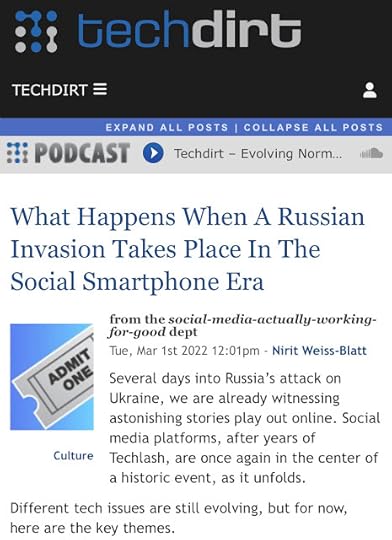
· Information overload
· Social media is fueling a new type of ‘fog of war’
· Once again, the Internet is being used as a weapon
· How can they moderate disinformation without distorting the historical record?
· What about the end-to-end encrypted messaging apps?
· The Russian government restricts access to online services
· Collective action & debunking falsehood in real-time
· Global protests, donations, and empathy
· Déjà vu to the onset of the pandemic
Check it out. Here’s the whole essay:
What Happens When A Russian Invasion Takes Place In The Social Smartphone Era
February 11, 2022
Yesterday’s Dot-Com, Today’s Web3/Blockchain?
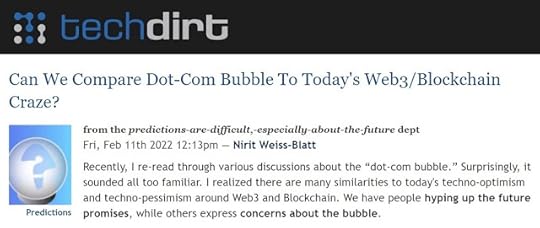
The Web3 debate – Explained:
- The Dot-Com Outspoken Optimism
- The Dot-Com Outspoken Pessimism
The Blockchain is Parting Like It’s 1999
- Web3 Outspoken Optimism
- Web3 Outspoken Pessimism
- A “Big Bang of Decentralization” is NOT Coming
- From “Peak of Inflated Expectations” to “Trough of Disillusionment”
- From a “Bubble” to a “Balloon”
Check it out. Here’s the whole essay:
Can We Compare Dot-Com Bubble To Today's Web3/Blockchain Craze?
December 5, 2021
The Techlash Audiobook is OUT NOW
If you need something geeky to listen to over the Holidays, the #TechlashAudiobook will do the trick.
It is OUT NOW on major retailers and libraries.
(& more are coming soon)
It tells the Techlash origin story. After finishing this audiobook, you could better explain “How did we get here?” & “Why is the Techlash only getting stronger?”
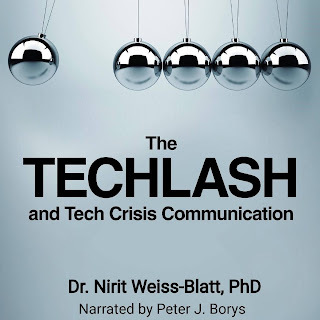
For sneak peeks, you can listen to some excerpts: SoundCloud Samples
The Retail Sample: “But our work will never be done”
November 19, 2021
“TECHLASH 2.0: The Next-Gen TECHLASH is Bigger, Stronger & Faster”
My new Opinion piece: Introducing: TECHASH 2.0.
Because it’s time to name this new trend.
“The Next-Gen of TECHLASH is bigger, stronger, and faster – just like the tech companies it’s fighting against.”
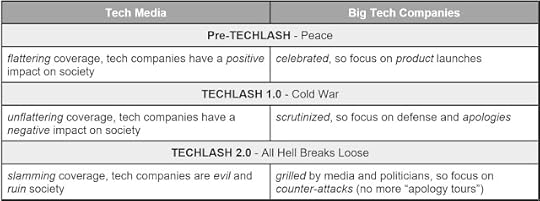
This also illustrates my point:

(as strange as it sounds, after reading the piece, it makes sense)
The full essay:
October 1, 2021
“Facebook: Amplifying the Good or the Bad? It’s Getting Ugly”
My new Opinion piece:
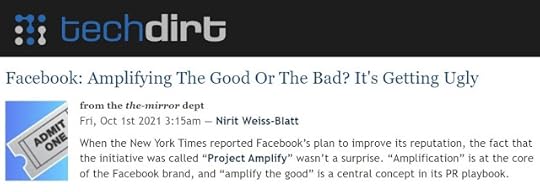
Does Facebook merely reflect (a mirror to the good and ugly) or shape (amplify the bad)? Is it the algorithms’ fault or the people who build them or use them? Fix the machine? The societal problems?
It all depends on whom you ask.
The full essay: https://www.techdirt.com/articles/20210928/16495447654/facebook-amplifying-good-bad-getting-ugly.shtml
August 18, 2021
"There's a Growing Backlash Against Tech's Infamous Secrecy. Why Now?"
My new Opinion piece:

For decades, the tech companies praised their secrecy. Tim Cookonce said, “One of the great things about Apple is: We probably have more secrecy here than the CIA.”
Now, as they are facing mounting criticism, their NDAs and off-the-record comments are seen as means of evading responsibility.
The full piece: https://www.techdirt.com/articles/20210816/21520947374/theres-growing-backlash-against-techs-infamous-secrecy-why-now.shtml
July 16, 2021
#TechlashBook on Podcasts – PRovoke Media
Thank you, Aarti Shah, for having me on your PRovoke Media podcast. I’m a fan and appreciate our discussion.
The transcript below, via OtterAI, was slightly edited for clarity.
PRovoke Media Podcast / Apple Podcast / Google Podcast / Spotify / Tune In / PodBean

Aarti: Is the word “Techlash” - too niche or too cute, or does it still apply?
Nirit Weiss-Blatt: I think that the definition of the Techlash still holds. In 2018, we started using the word Techlash to describe this widespread negative reaction to the big tech companies and around their growing influence in power. I think that the description is still accurate because the backlash that you see today in the media and the political pushback around those dominant companies and specific sectors like social media; they are accusing them of a lot of corporate misdeeds and harms. So, it all evolved in this trend of the Techlash. And I think it is only getting stronger.
The actual definition, I mean, Oxford Dictionary (was 2018), but the actual use of the word, we started to use it at the end of 2016, mainly in 2017. But the real usage in the media, and I’m researching the media, was at the end of 2017, you saw more and more articles describe the backlash as the Techlash.
Aarti: I want to talk about the op-ed you wrote for NEWSWEEK. You point out that in 2008, Facebook’s community standards were one page long, and not terribly specific. And today, it’s a document of about 50 pages printed. Can you tell us a little bit about that evolution?
Nirit Weiss-Blatt: Well, the internet got bigger, and so did the content moderation challenges. I mean, we had a simpler world back then. When I looked, for example, at the companies’ peaks of coverage in 2012, in the pre-Techlash years, it was about their product launches that are exciting. It was business reporting. It was not the tons of scandals that we have today. And the reason that we have tons of scandals today is because we have the Techlash issues, such as content moderation, misinformation, disinformation, all the hate speech, all those wars about speech online.
When that evolved, the companies evolved as well. Their messaging over the years of the Techlash is that “we were good. We had good intentions and previous good deeds, and we had strict policies. But our platform was misused by bad malicious actors. And as the bad actors evolve, we need to evolve as well.” So, what they are basically saying, again and again, is that “we have a lot more work to do. We know we need to do better.” But they also say that there have “strict policies that are consistent and can be enforced in a consistent way.” But they are revisited at any time, and they are changing due to new realities. So, they cannot be enforced consistently.
As we said, the criticism is clearly bipartisan, so both sides blame the companies, but for totally different reasons. So, I think that when the companies try to mitigate all the criticism, they’re doing their experiments with new enforcement protocols, new policies and see if that can somehow help them.
The thing is that if you look at what the Oversight Board published last month, it says, “Facebook cannot make up the rules as it goes.” What I saw, and speaking to tech executives, they were like, “but this is the opposite of what we are supposed to do, because of everything that is happening. We didn’t have Donald Trump before; we didn’t have COVID-19 before. So, our policies years ago could not predict those things that we need to handle today.”
“And even the issues that we need to handle today, we have the opposite arguments about what we are supposed to do.” So, basically, they are saying, “we’re damned if we do and damned if we don’t, but we’re trying something.” And they are getting backlash from both sides, no matter what they are doing, anyway.
- Aarti: In the same Newsweek piece, you also mentioned how Google’s privacy policies have evolved from 600 words to today, where it’s more than 4,000 words. You point out that in The Atlantic, there is a piece in which I’ll just read the quote directly; it’s very good: “The policies are always changing and can be revisited at any time, yet these inconsistent rules will be enforced consistently. It’s a mess.” Are you seeing any consistency around how these policies are being created?
Nirit Weiss-Blatt: The only consistency I’m saying is in the press releases and corporate blogs. There, you will find a real copy-paste. Because the text from 2017 and 2018, and I’m analyzing all of their press releases, it is basically the same messages again and again and again.
This is why I wrote at the end that “those of us who chronicle the companies’ responses, live in a tech response ‘Groundhog Day,’” because it’s like, “But we saw this message, like two scandals ago and nothing changed,” right?
Basically, what they’re saying is, “we have the bad actors who don’t comply with our policies. And we immediately remove the wrongdoing and doing our best, but we have more work to do.” Then, another thing has happened. And then, you go back and find more horrible things. And then, you’re saying, “but you should have fought this issue like years ago, when you said, ‘we know we need to do better and a lot of work to do.’” But we are years after that, still dealing with the same thing.
This is why Mark Zuckerberg called it an “arms race.” So, there’s always this battle. And when you look at how the media is covering, and then how they respond and how the media is covering their response, it’s like this never-ending, challenging, and criticism cycle that is just… I don’t see a way out for them.
Aarti: In addition to your book, there’s a book coming out called “An Ugly Truth.” On the book’s jacket, they have quotes from Mark Zuckerberg and Sheryl Sandberg kind of saying the same thing again and again, about “we need to do better,” and apologies for missteps. This is the strategy, isn’t it?
Nirit Weiss-Blatt: Yeah. Regarding the “apology tours” that Facebook is most famous about, I call them pseudo-apologies in the book because when I looked at the Crisis Communication literature: It’s not enough to say, “we’re sorry; we deeply apologize for wrongdoing,” if the rest of the messaging is trying to avoid responsibility with victimization, “it was us versus the bad actors. We are suffering from the malicious actors, and we’re the good guys here,” and scapegoating - blaming others, and given all of the excuses, then, it’s not a real apology, right? This is why it was perceived as a not a true apology, anyway.
Aarti: Banning Donald Trump from the platforms – is it seen as a turning point?
Nirit Weiss-Blatt: When I’m looking at turning points, I think the first turning point was the election of Donald Trump. It is what caused the Techlash anyway. Then, they needed to handle a lot of mounting criticism regarding issues they didn’t need to be dealt with beforehand.
Now, if we look at the 2020 election, there was this fear of how the tech platforms will allow misinformation and disinformation. But I think it blew up in the civil unrest on January 6. I think it is where the tech platforms were like “the villain” again if you look at the framing. They were, again, the ones to blame.
And when you have Biden and his administrations going after them with all those investigations and hearings and the new Antitrust bills, it feels like it’s really now just getting stronger because you have the democrats fighting the fight, a different fight against big tech than the Republicans.
Aarti: What’s the motivation for communications folks to kind of up the “anti” and say, “Hey, we need to be more sincere, or we need to have some more actions to back some of these statements”?
Nirit Weiss-Blatt: Well, I think that the way I’m looking at it is: I’m looking at the crisis responses and how they backlashed, and I’m analyzing that. So, the thing that didn’t work and backlashed heavily in the media is, as I said, the victimization as scapegoating, etc. What I think is missing in their messages are few basic things.
One thing that I think created the tension between tech journalists and the tech PR people is the secrecy and the limited access. I think the main call here is for more transparency. You’re a private company; you don’t have to reveal everything. But we need to know more in order to regain more of the trust that got lost.
But I think if COVID showed us something is, yeah, the users, as you said, heavily rely on, it saved their work and other things. But I think we have two narrativeshere.
The first is, “yes, they saved us. They are the builders of the future. They’re innovative, and they are important for the economy and for our lives.” This is one.
The other narrative is, of course, the Techlash narrative, which is “they are evil, the villains, Mark Zuckerberg on the cover is the bad guy, and they harm society.”
I think both narratives are in the extremes. None of them is correct. The reality is somewhere in the middle. And we need a more realistic narrative.
PR professionals need to push this more realistic (narrative): “Yeah, we’re not all good/everything is perfect. And also, not all bad. We have nuances. We have trade-offs. And we need to discuss the trade-offs and educate the people about the trade-offs.” I think people would appreciate that.
Aarti: Traditionally, it’s been about secrecy, right? Like that’s how tech PR has operated. You could argue that Apple and Facebook kind of led the way around that. There was a piece in Mother Jones recently about Amazon and how they are relentlessly asking for corrections as sort of their tactic in terms of bullying people away from covering some of the darker sides of the company. What practices are you seeing right now are most prevalent? Is it still the secrecy?
Nirit Weiss-Blatt: Yes, definitely. I think historically, the tech companies had in this power relation, the power to take advantage of the need for tech information. So, they had restricted their access only to reporters they liked, and most visits to their campuses diminished due to NDAs (non-disclosure agreements). I think many conversations were “on background” because it’s convenient. So, the journalist cannot share or use any of the info gathered. And it is pretty much still common practice today.
But the roots are in the historical power relations between the two groups. I think “Access Journalism” is an untold factor in the “Cold War” between the tech journalists and tech PR professionals. I mean, “if you don’t let us in, don’t be surprised that other voices, critical ones, are the ones featured in the coverage.”
Aarti: What are the narratives that are dominating the tech media right now?
Nirit Weiss-Blatt: I think two narratives that are fighting now is if you look on one side, you have, let’s say, the New York Times tech journalists, they would continue to produce their criticism and they’ll talk about how everything is evil and a threat, then – there’s a lot to fix.
On the more PR flattering piece/side of it, let’s say Future.com, you see how the tech industry is society’s savior, so – there’s a lot to build. This is a different narrative. So, I think it depends on who you ask.
Aarti: What do you think the implications are for Techlash then, as those two narratives take hold?
Nirit Weiss-Blatt: Well, I think we’re going to see more and more of the media being obsessed about the negative because it’s clearly its job. And people who call for it, “you are over-correcting to past, and you should be more balanced,” it won’t happen. The balance would come from having, as I said, them focusing on the wrongdoing, which is okay, literally their job. And the users, as you said, and the companies appreciating (maybe) the innovation more, but they have this criticism in mind.
I think having those things together in this play is actually necessary, even though I’m against the extreme ends of it. I think, if you look at the ecosystem as a whole, it doesn’t allow stagnation. Because then you have to move, which is, as I said, for either “to fix” -or- “to build.”
Aarti: I think about the role that the tech sector is going to play as we reimagine the workplace. How do you think that’s going to play into the Techlash narrative, as the rest of the country looks to technology companies to lead the way around what the workplace of the future might look like?
Nirit Weiss-Blatt: Sure. I mentioned Future.com. So, one of the first articles there, by Marc Andreessen, was about how tech is saving us and the workplace and make it available for people who are living in suburbia be part of a big tech company. I live in Cupertino. My view here is Apple’s spaceship that was built in like $4 billion. What we had a few weeks ago is that some employees said, “No, we don’t want to go back. Because we live far away, it’s cheaper. We don’t want the traffic.” Then, some of the backlashes were, “how dare you? You have this glorious place in here to go to work.”
But I think deeper than that, is that yes, technology enables them, and others that don’t live in the expensive Bay Area, to be part of the tech ecosystem. And then, you have more diversity and your workforce more inclusive. I think this is a huge plus for the tech companies to say, “yeah, we promote exactly that. It’s part of our value proposition. It’s the thing that we believe in.”
Aarti: Can you comment a little bit on this apolitical workplace culture versus having a point of view on some social issues?
Nirit Weiss-Blatt: Yeah, I think one of the things I’m emphasizing in the book that really changed throughout the year is in-house tech workers’ activism. Through the Techlash years, we have more and more employees feeling that they can and should speak up about things they don’t like and issues that they didn’t speak about before, specifically, not with their name attached. You have much more whistleblowers now, even though they face retaliation and they feel harmed by going up and open. But other workers see the impact in the real world and join the trend.
So, you’re going to see more and more employees raising their voice about things that they don’t like because they have more and more power to do so.
June 28, 2021
NEWSWEEK OpEd: “Big Tech’s Art of Making Up the Rules as It Goes”
My new Opinion piece in @Newsweek magazine:
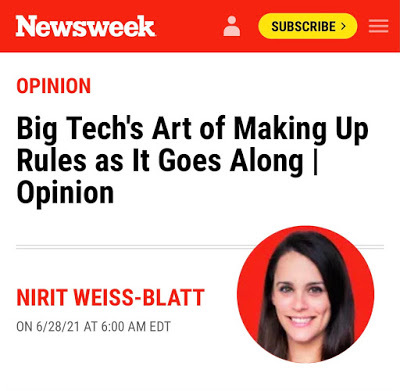
The tech platforms believe they have "more work to do" which "will never be done," but their inconsistent policies can be enforced consistently.
"Those of us who chronicle the companies' responses live in a tech-response 'Groundhog Day'"
The full piece: https://www.newsweek.com/big-techs-art-making-rules-it-goes-along-opinion-1603543
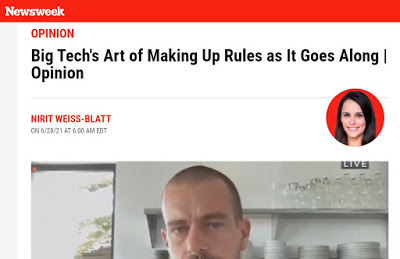
My new NEWSWEEK OpEd: “Big Tech’s Art of Making Up the Rules as It Goes”
My new Opinion piece in @Newsweek magazine:

The tech platforms believe they have “more work to do” which “will never be done,” but their inconsistent policies can be enforced consistently.
“Those of us who chronicle the companies’ responses, live in a tech-response ‘Groundhog Day’"
The full piece: https://www.newsweek.com/big-techs-art-making-rules-it-goes-along-opinion-1603543




